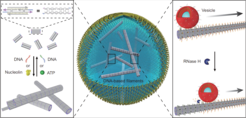Another step towards synthetic cells
Introducing functional DNA-based cytoskeletons into cell-sized compartments
Building functional synthetic cells from the bottom up is an ongoing effort of scientists around the globe. Their use in studying cellular mechanisms in a highly controlled and pre-defined setting creates great value for understanding Nature as well as for developing new therapeutic approaches. Scientists at the Max Planck Institute for Medical Research and colleagues at the University of Stuttgart have now been able to take the next step towards synthetic cells: they introduced functional DNA-based cytoskeletons into cell-sized compartments. Cytoskeletons are essential components of each cell that control their shape, internal organization and other vital functions such as transport of molecules between different parts of the cell. When the cytoskeletons were incorporated into synthetic droplets, the researchers could show functionality such as transport of molecules or assembly and disassembly in response to certain triggers. The results were recently published in Nature Chemistry.
The cytoskeleton is a crucial component of each cell and it is made up of various proteins. Beyond the basic function of giving the cell its shape, it is essential for many cellular processes such as cell division, intracellular transport of various molecules or motility in response to external signaling. Due to its importance in natural systems, being able to mimic its functionality also in an artificial setup is an important step towards building and designing a synthetic cell. However, it comes with many challenges due to the diverse requirements, including both stability and rapid adaptability and responsiveness to triggers.
Researchers in the field of synthetic biology have previously used DNA nanotechnology to recreate cellular components such as DNA-based mimics of ion channels or cell-cell linkers. For this, they exploit the fact that DNA can be programmed or engineered to self-assemble into a pre-planned shape by complementary base-pairing.
Furthermore, scientists including Paul Rothemund, Elisa Franco and Rebecca Schulman had already been successful in assembling DNA into micron-scale filaments, which constitute the basis for building a cytoskeleton. Since then, these filaments have been equipped with diverse functions, such as assembly and disassembly upon external stimulation or inside a compartment. Scientists from the MPI for Medical Research and the University of Stuttgart have now taken the next step towards building an artificial cell, by using the filaments as a synthetic cytoskeleton and giving them diverse functionalities.

“It is exciting that we can also trigger the assembly of the DNA cytoskeleton with ATP – the same molecule that cells use to power different mechanisms”, says Kerstin Göpfrich, Max Planck Research Group Leader at the MPI for Medical Research. Moreover, the team was able to induce the transport of vesicles along the filaments using the burnt-bridge mechanism introduced by Khalid Salaita. This mimics the vesicle transport along parts of the natural cytoskeleton in cells, the microtubuli. “In comparison with transport in living cells, transport along our DNA filaments is still slow. Speeding it up will be a challenge for the future”, says Kevin Jahnke, joint first author of the paper and postdoc in Kerstin Göpfrich’s group at the MPIMR. Pengfei Zhan, a postdoc in the group of Na Liu in Stuttgart, adds: “It was also a challenge to fine-tune the energy landscapes of the DNA nanostructure’s assembly and disassembly capabilities of the filaments.” In the future, functionalizing the DNA filaments even further will be crucial to mimicking natural cells even better., Researchers could thereby create synthetic cells to study cellular mechanisms in greater detail or develop new therapeutic approaches.
